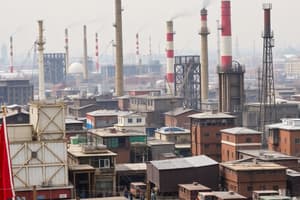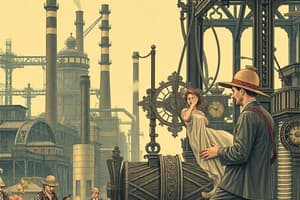Podcast
Questions and Answers
What was the primary focus of Theodore Roosevelt's Big Stick policy?
What was the primary focus of Theodore Roosevelt's Big Stick policy?
- Isolationism in foreign affairs
- Economic sanctions against hostile nations
- Negotiation backed by the threat of force (correct)
- Expanding territory through military conquest
Which of the following was a consequence of Prohibition in the United States?
Which of the following was a consequence of Prohibition in the United States?
- Improvement in public health
- Rise of speakeasies and bootlegging (correct)
- Decrease in organized crime
- Increase in legal production of alcohol
What was the impact of Wilson's Fourteen Points on post-war negotiations?
What was the impact of Wilson's Fourteen Points on post-war negotiations?
- They inspired a lasting peace agreement
- They were rejected by European allies (correct)
- They created new military alliances
- They were widely accepted with no changes
What does the term nativism refer to?
What does the term nativism refer to?
Which program was part of Franklin D. Roosevelt's New Deal?
Which program was part of Franklin D. Roosevelt's New Deal?
What is a major characteristic of the Roaring 1920s?
What is a major characteristic of the Roaring 1920s?
What were governmental reforms aimed at achieving?
What were governmental reforms aimed at achieving?
How did the Great Depression primarily affect American society?
How did the Great Depression primarily affect American society?
Which was a goal of consumer protections?
Which was a goal of consumer protections?
What is the primary goal of labor unions?
What is the primary goal of labor unions?
What did home front mobilization during World War I involve?
What did home front mobilization during World War I involve?
Which term describes a market structure dominated by a single company?
Which term describes a market structure dominated by a single company?
What was the objective of the Homestead Act?
What was the objective of the Homestead Act?
What did the 'Gospel of Wealth' promote?
What did the 'Gospel of Wealth' promote?
What was the significance of the case Plessy v. Ferguson?
What was the significance of the case Plessy v. Ferguson?
What is Social Darwinism?
What is Social Darwinism?
Which of the following describes 'yellow journalism'?
Which of the following describes 'yellow journalism'?
What was the main purpose of the Dawes Act?
What was the main purpose of the Dawes Act?
What does 'urbanization' refer to?
What does 'urbanization' refer to?
What was a primary aim of the anti-imperialists in the context of American expansion?
What was a primary aim of the anti-imperialists in the context of American expansion?
Which of the following best describes the primary action of home front mobilization during World War I?
Which of the following best describes the primary action of home front mobilization during World War I?
What was a significant consequence of the Great Depression on American society?
What was a significant consequence of the Great Depression on American society?
What did Wilson's Fourteen Points primarily advocate for after World War I?
What did Wilson's Fourteen Points primarily advocate for after World War I?
Which cultural movement is most associated with the celebration of African American culture during the 1920s?
Which cultural movement is most associated with the celebration of African American culture during the 1920s?
What was one of the primary objectives of consumer protection laws during the early 20th century?
What was one of the primary objectives of consumer protection laws during the early 20th century?
What was a common misconception about Prohibition during its enactment?
What was a common misconception about Prohibition during its enactment?
Which statement accurately reflects Hoover's responses to the Great Depression?
Which statement accurately reflects Hoover's responses to the Great Depression?
What does the term 'nativism' primarily relate to?
What does the term 'nativism' primarily relate to?
What was one of the critical impacts of the New Deal on American society?
What was one of the critical impacts of the New Deal on American society?
What is a primary characteristic of laissez-faire economics?
What is a primary characteristic of laissez-faire economics?
What was the main purpose of labor unions during industrialization?
What was the main purpose of labor unions during industrialization?
Which of the following best explains the concept of assimilation regarding immigrants?
Which of the following best explains the concept of assimilation regarding immigrants?
What was a significant impact of urbanization during the Gilded Age?
What was a significant impact of urbanization during the Gilded Age?
Which statement best describes the purpose of the Homestead Act?
Which statement best describes the purpose of the Homestead Act?
What do Jim Crow laws represent in American history?
What do Jim Crow laws represent in American history?
What was the goal of the Dawes Act regarding Native Americans?
What was the goal of the Dawes Act regarding Native Americans?
Which of the following reflects the concept of Social Darwinism?
Which of the following reflects the concept of Social Darwinism?
What does the term yellow journalism refer to?
What does the term yellow journalism refer to?
What was the aim of the Populist Movement?
What was the aim of the Populist Movement?
Flashcards
Laissez-faire
Laissez-faire
An economic system where the government has little to no intervention in business activities.
Monopoly
Monopoly
A market structure where a single company dominates the market, eliminating competition.
Labor Unions
Labor Unions
Organizations formed by workers to advocate for better working conditions and rights.
Urbanization
Urbanization
Signup and view all the flashcards
Tenements
Tenements
Signup and view all the flashcards
Push Factors
Push Factors
Signup and view all the flashcards
Pull Factors
Pull Factors
Signup and view all the flashcards
Assimilation
Assimilation
Signup and view all the flashcards
Nativism
Nativism
Signup and view all the flashcards
Jim Crow Laws
Jim Crow Laws
Signup and view all the flashcards
Big Stick Policy
Big Stick Policy
Signup and view all the flashcards
Progressivism
Progressivism
Signup and view all the flashcards
Prohibition
Prohibition
Signup and view all the flashcards
Harlem Renaissance
Harlem Renaissance
Signup and view all the flashcards
Great Depression
Great Depression
Signup and view all the flashcards
New Deal
New Deal
Signup and view all the flashcards
Home Front Mobilization
Home Front Mobilization
Signup and view all the flashcards
Civil Liberties
Civil Liberties
Signup and view all the flashcards
Wilson's Fourteen Points
Wilson's Fourteen Points
Signup and view all the flashcards
Consumerism
Consumerism
Signup and view all the flashcards
Hoover's responses
Hoover's responses
Signup and view all the flashcards
Impact of Depression & ND
Impact of Depression & ND
Signup and view all the flashcards
Captains of Industry
Captains of Industry
Signup and view all the flashcards
Gospel of Wealth
Gospel of Wealth
Signup and view all the flashcards
Populist Movement
Populist Movement
Signup and view all the flashcards
Robber Barons
Robber Barons
Signup and view all the flashcards
Gilded Age
Gilded Age
Signup and view all the flashcards
Patronage
Patronage
Signup and view all the flashcards
Indian Reservations
Indian Reservations
Signup and view all the flashcards
Plessy v. Ferguson
Plessy v. Ferguson
Signup and view all the flashcards
Study Notes
Industrialization
- Laissez-faire: Economic system with minimal government regulation, allowing businesses to operate freely.
- Monopoly: A market dominated by a single company, lacking competition.
- Robber Barons: 19th-century industrialists accused of exploiting workers and using unethical tactics for wealth.
- Captains of Industry: Business leaders lauded for promoting industrial growth.
- Labor Unions: Organizations of workers advocating for improved working conditions and rights.
- Urbanization: Increased population density in cities.
- Tenements: Overcrowded and substandard apartment buildings in urban areas.
Immigration & Race Relations
- Push Factors: Circumstances prompting people to leave their home country.
- Pull Factors: Conditions attracting people to a new country.
- Assimilation: Immigrants adopting the culture of their new country.
- Nativism: Favoring interests of native-born citizens over immigrants.
- Jim Crow Laws: Laws enforcing racial segregation in the Southern United States.
- Plessy v. Ferguson: Supreme Court ruling upholding "separate but equal" racial segregation.
The West
- Homestead Act: Law providing free land in the West to settlers who farmed it for five years.
- Transcontinental Railroads: Connecting the East and West coasts by rail.
- Indian Reservations: Lands designated for Native Americans, often resulting from forced relocation.
- Dawes Act: Law attempting to assimilate Native Americans by dividing tribal lands.
Gilded Age
- Social Darwinism: Belief that only the "fittest" succeed in society.
- Patronage: Granting government jobs to political supporters.
- Civil Service: System of hiring government employees based on merit, not political connections.
- Gospel of Wealth: Philosophy stating the wealthy have a responsibility to improve society.
- Social Gospel: Applying Christian principles to social problems.
- Populist Movement: Political movement advocating for the interests of ordinary people.
Imperialism
- Yellow Journalism: Sensationalized news to influence public opinion and attract readers.
- Spanish-American War: US conflict with Spain in 1898 resulting in territorial gains.
- Anti-Imperialists: Opponents of American expansion.
- Big Stick Policy: Theodore Roosevelt's foreign policy emphasizing diplomacy backed by military strength.
Progressivism
- Political Parties: Organized groups with shared political goals.
- Governmental Reforms: Improvements aimed at enhancing government efficiency and fairness.
- Business Reforms: Regulations designed to improve fair business practices.
- Consumer Protections: Laws safeguarding consumer rights.
- Environmental Protections: Efforts to conserve natural resources and decrease pollution.
World War I
- American Entry: Reasons behind the US involvement in World War I.
- Home Front Mobilization: Supporting the war effort from home.
- Civil Liberties: Individual rights protected by law.
- Wilson’s Fourteen Points: President Woodrow Wilson’s plan for peace and international cooperation.
The Roaring Twenties
- Nativism: Favoring native-born citizens over immigrants.
- Prohibition: Legal ban on alcohol (1920-1933).
- Consumerism: Promotion of consumer interest and spending.
- Harlem Renaissance: Cultural and artistic movement celebrating African American culture.
Depression & New Deal
- Great Depression: Severe worldwide economic downturn (1930s).
- Hoover's Responses: Hoover's attempts to combat the Great Depression.
- New Deal: Roosevelt's programs/policies to address the Great Depression.
- Impact of Depression & New Deal: Effects of the Depression and New Deal on American society and economy.
Studying That Suits You
Use AI to generate personalized quizzes and flashcards to suit your learning preferences.





